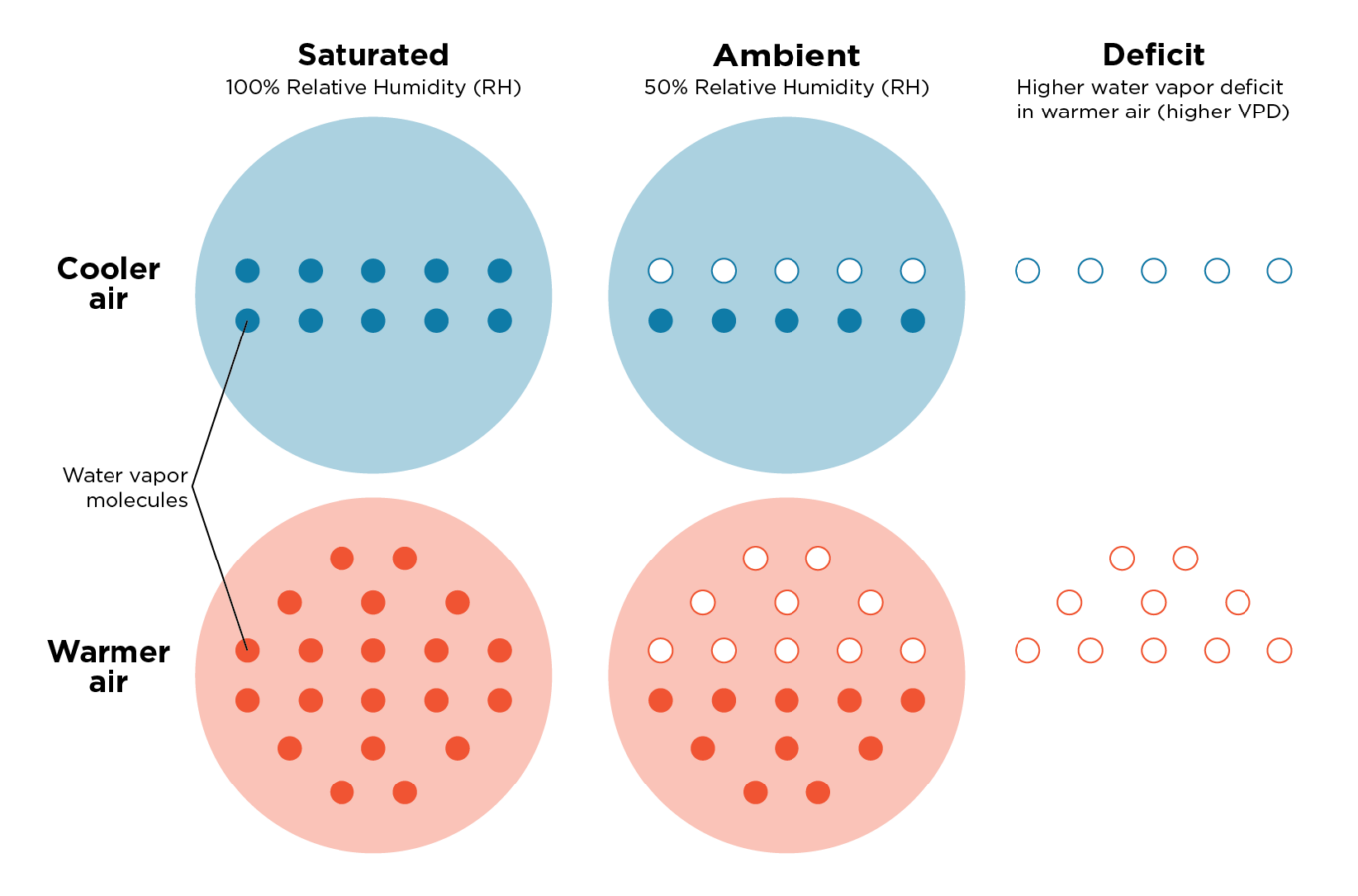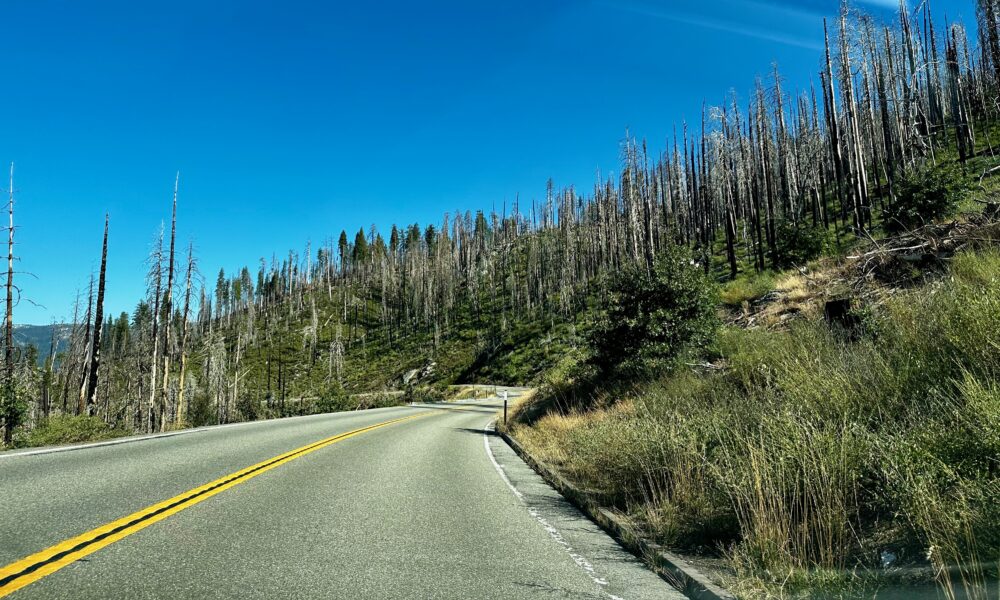California is no stranger to the impacts of climate change. From droughts to wildfires to rising sea levels and torrential rains, the state has felt the effects of a changing climate in a variety of ways. One measure of climate that is of particular concern in California is vapor pressure deficit (VPD), as it has far-reaching implications for people’s health and safety, ecosystem conservation, and economy. In this blogpost, we will explore what vapor pressure deficit is, how it is affected by climate change, and its implications for California.
What is vapor pressure deficit?
Vapor pressure deficit is a measure of how dry or humid the air is. When it’s hot outside, the air can hold a lot of water vapor. When it’s cooler outside, the air can’t hold as much water vapor. The difference between how much water vapor the air can hold and how much it actually contains is called the vapor pressure deficit, or VPD.
So, if the air can hold a lot of water vapor (it is warmer) but only has a little bit in it, then the vapor pressure deficit is high. But if the air can’t hold much water vapor (it is cooler), then the vapor pressure deficit can be low even if there’s a fair amount of water vapor in it. In simple terms, VPD is the difference between the actual amount of moisture in the air and the amount of moisture that the air could hold if it were saturated.

How is vapor pressure deficit affected by climate change?
Vapor pressure deficit is closely related to temperature and climate change is causing temperatures to rise. VPD has been on the rise in most regions of the world, including the Western United States. The increase regional VPD is mostly attributed to human-cause climate change (68%) and the rest (32%) is attributed to variations in the atmospheric circulation.
Incremental changes in vapor pressure deficit due to climate change are linked to interrelated threats. For example, high VPD can impact the health of forests, as trees and other vegetation require a certain amount of moisture to grow and thrive. Increases in VPD over since the late 90’s have led to increasing forest drought and tree mortality. As dry air and dry vegetation create ideal conditions for fire to spread, high VPD also leads to an increase in wildfire risk. Additionally, it can reduce crop yields or augment water demands as some plants, like crops, will require more water to survive and produce fruit.
Implications for California
The increasing trend of vapor pressure deficit in California is concerning. As temperatures continue to rise and the air becomes drier, the implications for the state’s people, agriculture, forests, and ecosystems are becoming increasingly evident.
For agricultural areas in California, vapor pressure deficit is of particular importance because the higher it is, the greater crops’ water needs are in a region already affected by overuse of water resources. High atmospheric “thirst” over multiple seasons or years can lead to drought conditions as vegetation dries out, and water flow in streams and rivers decreases. These consequences are currently being experienced acutely across western North America amidst a 23-year-long megadrought. In California alone, crop revenue losses due to drought totaled $3.0 billion over the 2021–2022 period.
Meanwhile, people in rural, underserved communities have lost water access or experienced drinking water contamination during the drought as overpumping of groundwater has caused its levels to fall. Reductions in water access affect people’s health and finances as they are forced to purchase bottled water or interim tanks, fix pumps, or drill new wells.
When drought compounds heatwaves, upticks in dust and air pollutants associated with extra energy use cause poor air quality in regions such as California’s Central Valley. As with the poor air quality associated with wildfire smoke, poor air quality during combined droughts and heat waves disproportionately affects outdoor workers, including farmworkers, and people in underserved communities. During these events, an increase in cases of heat-related illnesses and asthma is common.
California has experienced a significant increase in the extent of forest fires in recent decades, with a fivefold increase in annual burned area from 1972 to 2018. Nearly all the increase in summer forest-fire area from 1972 to 2018 was due to increased VPD. In turn, human-caused climate change was responsible for roughly two-thirds of the increase in VPD over those decades.
In a single year (2018), California wildfires had an estimated cost of nearly $150 billion, including capital losses, health costs, and indirect losses due to broader economic disruption cascading across regional and national supply chains. This shows that wildfires have far-reaching economic and health impacts beyond specific communities, and there is a need for greater investments in reducing fire risk, including by jurisdictions indirectly affected by the related pollution and economic disruption.
While there is not enough research on the direct effects of high vapor pressure deficit in people (likely due to many other variables affecting the body), we know that higher temperatures increase the risk of heat-related illnesses because it makes it harder for the body to cool itself through sweating. This leads to dangerous increases in body temperature and dehydration, especially among vulnerable populations like the elderly, young children, and people with higher exposure to heat like outdoor workers.
As California faces the increasing effects of climate change, the role of rising vapor pressure deficit cannot be ignored. It is essential to acknowledge that the rise of vapor pressure deficit is linked to many interrelated concerns, and the impact of the problem will only worsen over time. However, there are actions that we can take to address the issue, including reducing greenhouse gas emissions, investing in forest management, and increasing resources for reducing fire risk.
If you want to learn more about Vapor Pressure Deficit, visit my colleague’s recent blog post.

